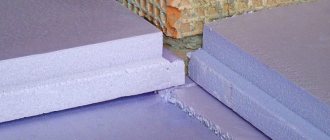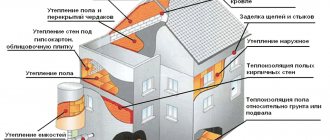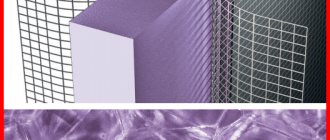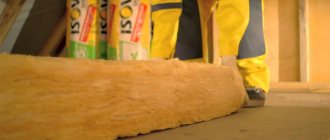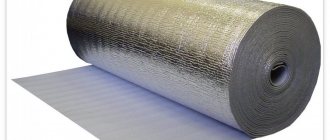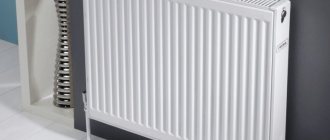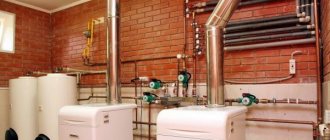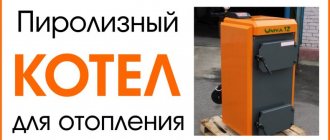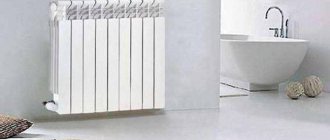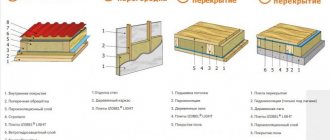Ursa mineral wool in rolls and slabs.
In the previous article we talked about mushroom dowels: their types and installation methods. Today we will help you understand what Ursa insulation is, the characteristics of mineral wool thermal insulation and extruded polystyrene foam. Ursa is a European company that has representative offices all over the world, including Russia. This brand is famous for the high quality of its product, the production process of which does not use toxic substances. Even the color of mineral wool and EPS from Ursa is not the same as that of competitors. The line is dominated by light colors.
Features of Ursa material
Ursa insulation based on fiberglass
Universal Ursa insulation effectively reduces heat loss and creates a comfortable microclimate in the room. Low specific gravity helps reduce the volume of building materials and energy consumption.
The URSA brand produces 2 types of products:
- thermal insulation based on Ursa expanded polystyrene (EPS);
- based on fiberglass.
The first category includes material made using extrusion technology. The foam particles combine with the foam under pressure and heat. The hot mass passes through the extrusion head of the unit and Ursa extruded polystyrene foam is obtained.
Insulation of the second category is produced by combining dolomites, quartz sand and soda. The substances are melted, and additives are added to the mass to glue the components together. The hot composition is forced through the nozzles of the extrusion unit.
URSA classification
There are many varieties of ursa, the technical characteristics of which differ from the purposes and objects of insulation, and they differ from each other in composition, geometry and dimensions, operational parameters, such as moisture permeability, thermal conductivity coefficient, temperature range of effective operation, and other characteristics. There are 5 classes of thermal insulation materials in demand on the Russian market:
- Glass wool brand "Geo";
- Insulation boards made of extruded polystyrene foam of the “XPS” brand;
- Rolled staple insulation of the “Pure One” brand;
- Mineral wool ursa terra;
- hydro-, steam- and wind-insulating film materials of the SECO brand.
All these materials have high mechanical strength and tensile strength, do not burn and are not susceptible to fungal diseases, but some groups, especially those based on mineral materials, must be protected from moisture during installation with special vapor barrier membrane films, and with such protection any ursa thermal insulation will serve 20 years or more.
Application of Ursa Terra insulation
Technical characteristics of mineral insulation
Indicators of the density and size of roll insulation and Ursa boards
The category of mineral insulation includes materials made from natural components, for example, fiberglass. Products are sold in slabs or rolls. The structure does not include phenolic substances to bind the ingredients, so Ursa mineral wool is an environmentally friendly product.
The composition contains sand, soda, and other non-combustible materials, so the insulation is characterized by increased fire safety indicators. The manufacturer indicates a period of 40-50 years of operation without destruction or loss of quality.
Insulation density
The density of a material is determined by the ratio of weight to volume. For glass wool, the indicator is determined on a scale of 15-85 kg/m3, depending on this the area of use is selected. In private houses, material with an index of up to 30 kg/m3 is used, and industrial insulation requires penoplex of higher density.
Thermal conductivity
The characteristic shows the ability of rolled and slab materials to conduct heat from heated to cold layers. Energy transfer occurs due to the movement of elementary particles in the insulation composition. Ursa mineral wool has a low ability to transfer heat, so it provides good insulation of structures and pipelines.
The lower the thermal conductivity coefficient, the better the protection from cold. For mineral wool, the indicator is within the range of 0.031-0.045 W/mK. This amount of energy passes through the thickness, which indicates the high thermal insulation qualities of the layer.
Application temperature
Technical characteristics of flammability and thermal conductivity
The characteristic determines the temperature range at which the insulation retains its specified properties. The manufacturer guarantees that Ursa polystyrene does not change its declared qualities at ambient temperatures down to -60˚C. The upper value is +310˚С.
These indicators relate only to the atmosphere, since the insulation surface can withstand other temperature loads, the limit of which is +100˚С, and some categories retain properties at +180˚С. The insulation belongs to the universal class and is suitable for protecting various structural elements from cold in any climate conditions.
The material is sold in the form of rolls or in the form of slabs. Rolled products are produced in thicknesses of 5-20 cm, width varies in the range of 60-120 cm. The length of mats is 3-18 m, and sheets are produced in sizes of 1.25 m.
Price
The most pressing question that can dot the i's. How much does insulation with URSA cost? As you probably already guessed, Pure One will be the most expensive. You have to pay for health. For example, a roll of Pur Van 37 RN 6.2 m long, 1.2 m wide, and 50 mm thick will cost 1,212 rubles. A, Terra, density characteristics - 18 kg/m3, dimensions 1000 by 600 and 50 mm, will cost 420 rubles for 10 slabs. Ursa Geo M 25 cotton wool, 9 meters long, 1.2 meters wide and 50 mm thick, will cost 900 rubles. The number of slabs in each package is different.
We have tried to focus here on technical details in order to provide as complete information as possible. When insulating your home or office, pay attention to the properties of this brand.
A line of materials based on mineral components
Mineral wool differs in fiber depending on the initial component underlying it. The structure can be spatial, corrugated, the layers are divided horizontally or vertically.
The manufacturer designates products depending on the raw material composition:
- Fiberglass products are marked with the Geo prefix. The products fall into the category of materials that are safe for humans and environmentally friendly.
- A product with the PureOne index is created on the basis of glass threads. The composition contains acrylic components. This type of insulation is installed to protect against cold in children's institutions and hospitals.
- The non-flammable Terra material is ideal for insulating wooden buildings. The composition includes natural components, the insulation does not harm the environment and humans.
- Thermal insulation based on extruded polystyrene foam is marked with the prefix XPS and is a durable and reliable insulating option for insulation.
Ursa thermal insulation is manufactured in accordance with technological standards that regulate the content of the binder.
Ursa GEO
Material marked Geo is environmentally friendly and does not emit harmful combustion products.
The heat insulator is allowed for use in rooms with a high risk of fire, since the material does not emit harmful components when heated.
Ursa Geo products are available in the following range:
- Light;
- Pitched roof;
- Frame P;
- Mini;
- Facade;
- Noise protection%
- Universal plates.
Mats with one foil side are designated M-11F and M-11, double-sided - M-25F, M-25, M-15. The slabs are marked P-60, P-15, P-45, P-20, P-30.
With a low specific gravity, Geo brand products provide high-quality protection from cold and noise, thanks to the original fibrous structure. The material does not decompose, does not burn, and rodents and insects do not settle in the thickness.
Ursa PureOne
The Pure One material does not emit dust during installation.
The characteristics of Ursa insulation show that the material consists of 95% natural substances, which underwent quality control during the production process. The material is produced in accordance with sanitary international standards and is included in the class of environmentally friendly insulators.
Line names:
- 35QN rolls measuring 1200 mm x 3900 mm;
- slabs 34PN with dimensions 1250 mm x 600 mm);
- rolls 37RN size 1200 mm x 100 mm).
The products are flexible when installed in curved structures due to the thinned fibrous elements in the structure. The material does not emit dust or odor during installation. The white color is obtained through the use of quartz sand.
Ursa TERRA
Terra material is available in the form of slabs.
The products were developed for private buildings, but also meet the requirements of professional construction. Plates of this type are distinguished by their small size and rigidity with sufficient elasticity and flexibility.
The following range of Terra brand insulation is produced:
- slabs 34 PN;
- mats for insulation of highways and ventilation ducts 34 RN.
The sheets are characterized by a good index of thermal and sound conductivity and show moisture-resistant qualities. The production technology involves the use of water-repellent additives.
Line of materials based on XPS
The materials have a low thermal conductivity (0.028-0.035 W/mK), have increased strength and low specific weight (45 kg/m³), which reduces the weight of the structure. Extruded polystyrene foam is characterized by closed cells in the structure, the diameter of which does not exceed 0.2 mm. This structure ensures moisture resistance in damp conditions.
URSA XPS
The insulation is resistant to loads and chemicals.
Only one type of product is produced in the EPS product category. The material has universal application, but is more often used for insulation work during the construction of railway embankments, runways, lower and underground floors of buildings.
Assortment of the URSA XPS line:
- high strength material NV, sold in slabs 60 x 125 cm;
- N-III sheets are available with straight and stepped side edges;
- N-III-G4 slabs are produced in thicknesses of 3-10 cm, size 60 x 125 cm.
The products do not react to the action of acids, fats, alkalis, lime, bitumen and other caustic substances, but decompose upon contact with tar, hydrocarbons, gasoline and formic acid.
Extruded polystyrene foam boards
This type of Ursa insulation also enjoys well-deserved popularity among private developers and large construction companies. Most often, expanded polystyrene slabs of this brand are used to insulate the foundations of buildings and structures. The fact is that they are not at all afraid of moisture and the effects of various types of aggressive chemical elements present in any soil. Ursa slabs can be installed completely without any additional protective material.
Main advantages
The service life without loss of properties is comparable to the operating time of the structures; the insulator ages simultaneously with them and does not require replacement. The high tensile strength of extruded polystyrene foam is its positive quality, which is why the material performs protective functions and works as additional structural elements that can withstand some loads.
When cutting, fiberglass crumbles, so you need to work with gloves and a mask
Advantages of Ursa materials:
- environmental cleanliness;
- increased noise protection qualities;
- long service life;
- resistance to temperature changes;
- wide range of applications;
- elasticity and resilience;
- fire resistance;
- ease;
- vapor permeability and biostability;
- not subject to decomposition and rotting.
There are some negative points when using it. For example, mineral wool decomposes upon direct contact with alkalis, and small fibers fall out of glass wool during the cutting process.
Areas of application
Ursa slab insulation can be used as a substrate for asphalt.
Ursa universal thermal insulation is used in any construction process. Universal characteristics allow the protection to be used for complex curved surfaces.
Areas of use:
- pitched and flat roofs;
- foundations in damp places;
- walls outside, inside and as an intermediate layer;
- partitions;
- heating lines;
- highways and railway elevations;
- airfield strips;
- extensions, balconies;
- saunas and baths.
Reliable thermal insulation is set to a minimum thickness, which is comparable to thicker layers of other materials. Internal insulation made from Ursa material does not reduce the horizontal and height dimensions of the room.
Dimension
Types of packaging
Many buyers of this material are primarily interested in the dimensions of a roll of Ursa insulation - after all, only knowledge of the dimensions allows one to accurately calculate how many rolls are required to perform certain jobs. (See also the article Insulation of building facades: types.)
And the dimensions of Ursa insulation are quoted as follows:
- length 10000 mm, width 1200 mm, thickness 100 mm for GLASSWOOL on pitched roofs;
- length 9000 mm, width 1200 mm, thickness can be either 50 mm or 100 mm - GLASSWOOL for various purposes,
- length 18000 mm, width 1200 mm, thickness 50 mm - with one or two canvases in the package. Used as a material for various purposes.
Important! At the same time, the cost of Ursa insulation varies depending on whether the material belongs to one of these types.
Installation of Ursa thermal insulation
Installation of roof insulation in wooden logs
Mineral wool is attached to the walls and pressed with 50x50 cm bars so that there is an air space between it and the finishing layer. Wooden elements are mounted at a distance of the width of the roll so that they hold the edges of the canvas. Expanded polystyrene boards are glued to the surface of walls or floors using cement-adhesive solutions or polyurethane composition. Before gluing, walls, ceilings or floors are treated with primer for better adhesion. A screed or starting putty is applied over them using a plaster mesh.
For reliable fastening to vertical surfaces, use special dowels with a large head (up to 10 cm). The ventilation gap between the insulation and the wall of the house ends at the bottom and top with vents - installation holes for normal air flow. Rolls and slabs are stacked tightly next to each other. If the material is placed in 2 layers, the next layer overlaps the joints of the previous one for maximum efficiency.
If a frame is used, a finishing finish is attached to it in the form of sheets of chipboard, fiberboard, OSB, plastic panels or MDF. Ursa insulator works well with all types of building finishes.
How to apply tile adhesive?
Applying tile adhesive
Preparing the base. The base on which you plan to glue the tiles should be cleaned of dirt (dust, grease, etc.). Small irregularities (up to 5 mm) can be covered with the same tile adhesive, then wait 24 hours before starting to work with the tiles.
It is recommended to prime concrete surfaces, cement screeds and gypsum plasters. The primer will additionally clean the surface from dust and increase the adhesion of the glue. Plus, the primed base will draw less moisture from the glue and increase the adjustment time.
Preparation of glue. The dry mixture for tile adhesive should be diluted with clean water at a temperature of +15..+20 °C. The sequence is as follows: first, water is poured into the container, and then the mixture is poured in with constant stirring. After which the solution is stirred with a mixer or drill with an attachment until smooth. Then the glue is allowed to sit for 5 minutes and gain strength. Then mix again and begin laying the tiles.
Applying glue. Tile adhesive is applied to the base with a regular spatula. After which they pass over it with a notched trowel to create a comb structure. The thickness of the glue layer is limited by the height of the spatula teeth. Typical sizes are 4, 6, 8, 10 and 12 mm.
After gluing the tile, the thickness of the adhesive layer decreases by about 2-3 times, filling the void under the tile. Therefore, to calculate the final thickness of the glued tiles, you can use the formula:
Coating thickness = Tile thickness + Trowel tooth height / 2
Example. Porcelain stoneware 8 mm thick is laid on the floor. A spatula with a tooth height of 12 mm is used. Then the thickness of the finishing coating will be equal to:
8 mm + 12 mm / 2 = 14 mm
Before you start tiling heated floors, you need to turn off the heating at least two days before the start of work, and turn it on no earlier than three days after laying the tiles.
Grouting joints. You can grind the seams after the glue has completely hardened. For most mixtures, grouting can begin 24 hours after gluing the tiles. The exception is quick-hardening glue - you can grout seams with it after 3 hours.
